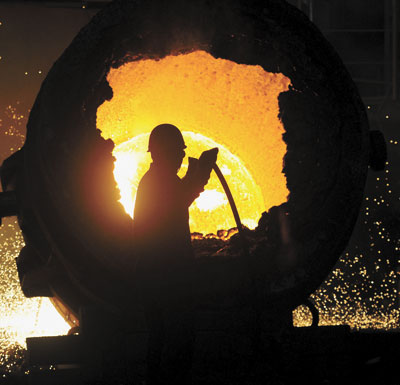|

THE government said yesterday it expects to lay off 1.8 million workers in the coal and steel sectors as part of efforts to reduce industrial overcapacity, but no timeframe was given.
China has vowed to deal with excess capacity and eliminate hundreds of so-called “zombie enterprises” — loss-making firms in struggling sectors that are being kept alive by local governments trying to avoid job losses.
Yin Weimin, the minister for human resources and social security, told a news conference that 1.3 million workers in the coal sector could lose jobs, plus 500,000 from the steel sector.
It was the first time a senior government official has given a number for job losses as China deals with industrial overcapacity amid slowing growth.
“This involves the resettlement of a total of 1.8 million workers. This task will be very difficult, but we are still very confident,” Yin said.
For the Chinese Government, keeping a lid on unemployment and any possible unrest that may follow has been a top priority.
The Central Government will allocate 100 billion yuan (US$15.27 billion) over two years to relocate workers laid off as a result of China’s efforts to curb overcapacity, officials said last week.
Vice Finance Minister Zhu Guangyao quoted Premier Li Keqiang as telling U.S. Treasury Secretary Jack Lew yesterday that the fund would mainly focus on the steel and coal sectors.
“The economy faces relatively big downward pressures and some firms face difficulties in production and operation, which would lead to insufficient employment,” Yin said, adding that increasing graduates this year would also add pressure in the job market.
China’s coal and steel sectors employ about 12 million workers, according to data published by the National Bureau of Statistics.
The number of layoffs was reasonable based on the government’s capacity closure targets, said Jiang Feitao, an industry researcher with the China Academy of Social Sciences, a top government think tank.
He said the funds being made available would be used only after the enterprises go bankrupt and settle their debts. He said local governments would also be responsible for dealing with those debts.
“It’s difficult to predict a timeframe but it will not be a quick process. There are many issues to be dealt with, including how to pay debt as well as layoffs.”
China’s economy grew 6.9 percent in 2015, the weakest in 25 years, and the government aims to achieve economic growth of 6.5-7 percent in 2016.
Despite of economic downturn, there have been no reports of mass layoffs as occurred during the global financial crisis, with the survey-based jobless rate published by the National Bureau of Statistics staying at around 5.01 percent at the end of last year.
The registered urban jobless rate published by the human resources and social security ministry was at 4.05 percent at the end of 2015.
Officials have said that the services sector has created more jobs to help absorb laid-off workers from the manufacturing sector.
In 2015, the contribution from the services sector to GDP climbed to 50.5 percent, surpassing 50 percent for the first time.
(SD-Agencies)
|

